Shimpei Masuda
TACT: Humanoid Whole-body Contact Manipulation through Deep Imitation Learning with Tactile Modality
Jun 18, 2025Abstract:Manipulation with whole-body contact by humanoid robots offers distinct advantages, including enhanced stability and reduced load. On the other hand, we need to address challenges such as the increased computational cost of motion generation and the difficulty of measuring broad-area contact. We therefore have developed a humanoid control system that allows a humanoid robot equipped with tactile sensors on its upper body to learn a policy for whole-body manipulation through imitation learning based on human teleoperation data. This policy, named tactile-modality extended ACT (TACT), has a feature to take multiple sensor modalities as input, including joint position, vision, and tactile measurements. Furthermore, by integrating this policy with retargeting and locomotion control based on a biped model, we demonstrate that the life-size humanoid robot RHP7 Kaleido is capable of achieving whole-body contact manipulation while maintaining balance and walking. Through detailed experimental verification, we show that inputting both vision and tactile modalities into the policy contributes to improving the robustness of manipulation involving broad and delicate contact.
Four-Axis Adaptive Fingers Hand for Object Insertion: FAAF Hand
Jul 30, 2024



Abstract:Robots operating in the real world face significant but unavoidable issues in object localization that must be dealt with. A typical approach to address this is the addition of compliance mechanisms to hardware to absorb and compensate for some of these errors. However, for fine-grained manipulation tasks, the location and choice of appropriate compliance mechanisms are critical for success. For objects to be inserted in a target site on a flat surface, the object must first be successfully aligned with the opening of the slot, as well as correctly oriented along its central axis, before it can be inserted. We developed the Four-Axis Adaptive Finger Hand (FAAF hand) that is equipped with fingers that can passively adapt in four axes (x, y, z, yaw) enabling it to perform insertion tasks including lid fitting in the presence of significant localization errors. Furthermore, this adaptivity allows the use of simple control methods without requiring contact sensors or other devices. Our results confirm the ability of the FAAF hand on challenging insertion tasks of square and triangle-shaped pegs (or prisms) and placing of container lids in the presence of position errors in all directions and rotational error along the object's central axis, using a simple control scheme.
Stable Object Placing using Curl and Diff Features of Vision-based Tactile Sensors
Mar 28, 2024



Abstract:Ensuring stable object placement is crucial to prevent objects from toppling over, breaking, or causing spills. When an object makes initial contact to a surface, and some force is exerted, the moment of rotation caused by the instability of the object's placing can cause the object to rotate in a certain direction (henceforth referred to as direction of corrective rotation). Existing methods often employ a Force/Torque (F/T) sensor to estimate the direction of corrective rotation by detecting the moment of rotation as a torque. However, its effectiveness may be hampered by sensor noise and the tension of the external wiring of robot cables. To address these issues, we propose a method for stable object placing using GelSights, vision-based tactile sensors, as an alternative to F/T sensors. Our method estimates the direction of corrective rotation of objects using the displacement of the black dot pattern on the elastomeric surface of GelSight. We calculate the Curl from vector analysis, indicative of the rotational field magnitude and direction of the displacement of the black dots pattern. Simultaneously, we calculate the difference (Diff) of displacement between the left and right fingers' GelSight's black dots. Then, the robot can manipulate the objects' pose using Curl and Diff features, facilitating stable placing. Across experiments, handling 18 differently characterized objects, our method achieves precise placing accuracy (less than 1-degree error) in nearly 100% of cases. An accompanying video is available at the following link: https://youtu.be/fQbmCksVHlU
SAID-NeRF: Segmentation-AIDed NeRF for Depth Completion of Transparent Objects
Mar 28, 2024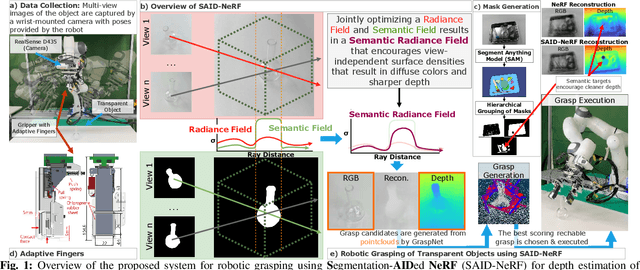
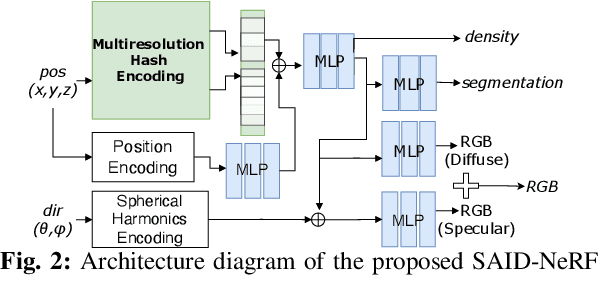
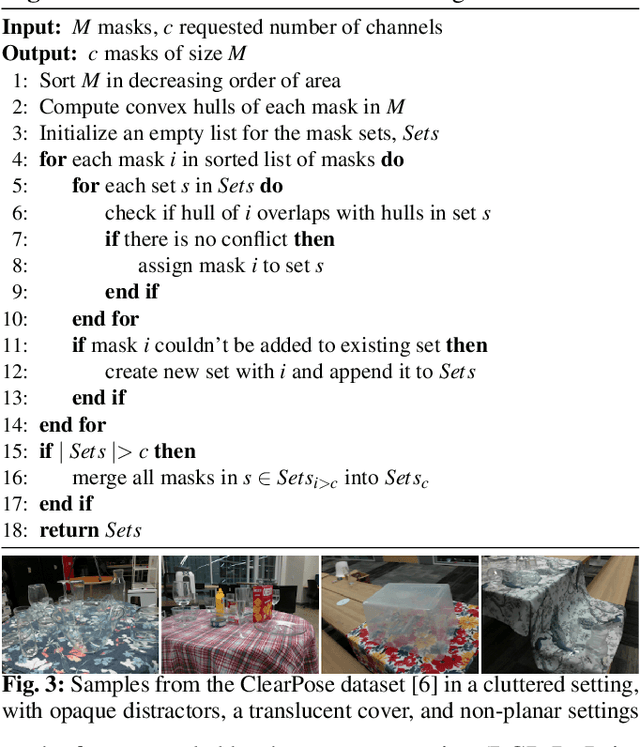

Abstract:Acquiring accurate depth information of transparent objects using off-the-shelf RGB-D cameras is a well-known challenge in Computer Vision and Robotics. Depth estimation/completion methods are typically employed and trained on datasets with quality depth labels acquired from either simulation, additional sensors or specialized data collection setups and known 3d models. However, acquiring reliable depth information for datasets at scale is not straightforward, limiting training scalability and generalization. Neural Radiance Fields (NeRFs) are learning-free approaches and have demonstrated wide success in novel view synthesis and shape recovery. However, heuristics and controlled environments (lights, backgrounds, etc) are often required to accurately capture specular surfaces. In this paper, we propose using Visual Foundation Models (VFMs) for segmentation in a zero-shot, label-free way to guide the NeRF reconstruction process for these objects via the simultaneous reconstruction of semantic fields and extensions to increase robustness. Our proposed method Segmentation-AIDed NeRF (SAID-NeRF) shows significant performance on depth completion datasets for transparent objects and robotic grasping.
Laboratory Automation: Precision Insertion with Adaptive Fingers utilizing Contact through Sliding with Tactile-based Pose Estimation
Sep 28, 2023



Abstract:Micro well-plates are commonly used apparatus in chemical and biological experiments that are a few centimeters in thickness with wells in them. The task we aim to solve is to place (insert) them onto a well-plate holder with grooves a few millimeters in height. Our insertion task has the following facets: 1) There is uncertainty in the detection of the position and pose of the well-plate and well-plate holder, 2) the accuracy required is in the order of millimeter to sub-millimeter, 3) the well-plate holder is not fastened, and moves with external force, 4) the groove is shallow, and 5) the width of the groove is small. Addressing these challenges, we developed a) an adaptive finger gripper with accurate detection of finger position (for (1)), b) grasped object pose estimation using tactile sensors (for (1)), c) a method to insert the well-plate into the target holder by sliding the well-plate while maintaining contact with the edge of the holder (for (2-4)), and d) estimating the orientation of the edge and aligning the well-plate so that the holder does not move when maintaining contact with the edge (for (5)). We show a significantly high success rate on the insertion task of the well-plate, even though under added noise. An accompanying video is available at the following link: https://drive.google.com/file/d/1UxyJ3XIxqXPnHcpfw-PYs5T5oYQxoc6i/view?usp=sharing
Sim-to-Real Learning of Robust Compliant Bipedal Locomotion on Torque Sensor-Less Gear-Driven Humanoid
Apr 08, 2022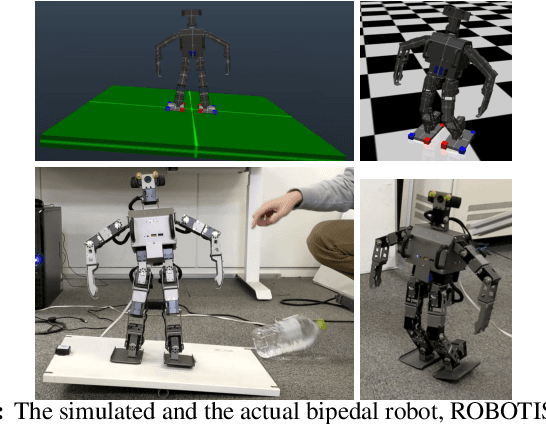
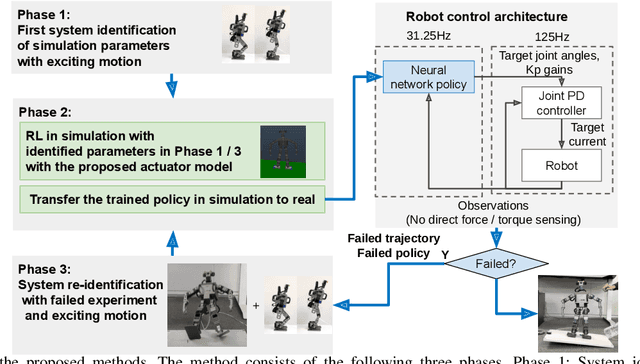
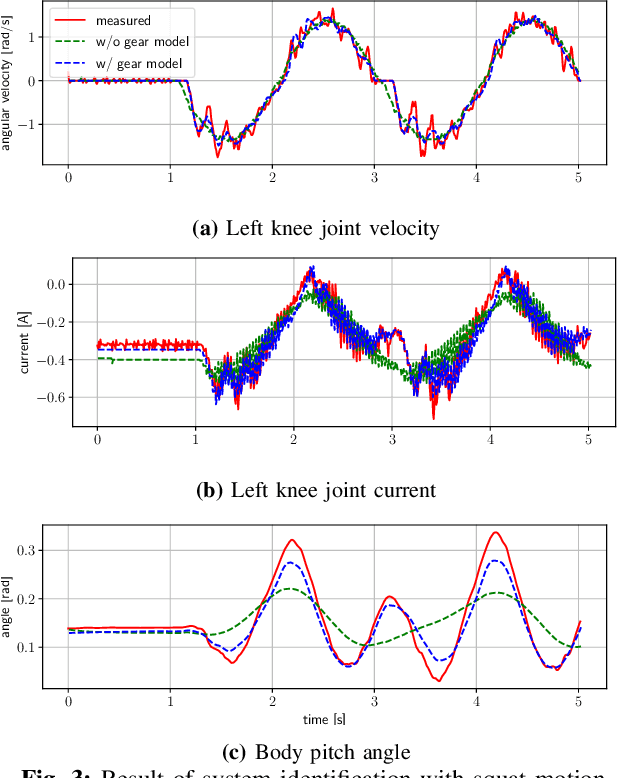
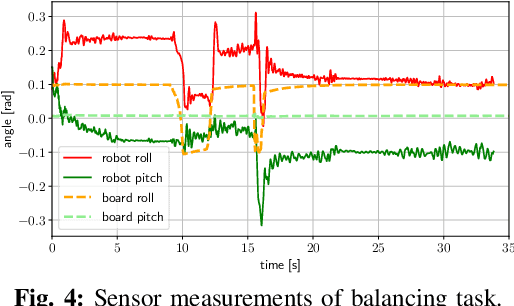
Abstract:In deep reinforcement learning, sim-to-real is the mainstream method as it needs a large number of trials, however, it is challenging to transfer trained policy due to reality gap. In particular, it is known that the characteristics of actuators in leg robots have a considerable influence on the reality gap, and this is also noticeable in high reduction ratio gears. Therefore, we propose a new simulation model of high reduction ratio gears to reduce the reality gap. The instability of the bipedal locomotion causes the sim-to-real transfer to fail catastrophically, making system identification of the physical parameters of the simulation difficult. Thus, we also propose a system identification method that utilizes the failure experience. The realistic simulations obtained by these improvements allow the robot to perform compliant bipedal locomotion by reinforcement learning. The effectiveness of the method is verified using a actual biped robot, ROBOTIS-OP3, and the sim-to-real transferred policy archived to stabilize the robot under severe disturbances and walk on uneven terrain without force and torque sensors.
Distributed Reinforcement Learning of Targeted Grasping with Active Vision for Mobile Manipulators
Jul 16, 2020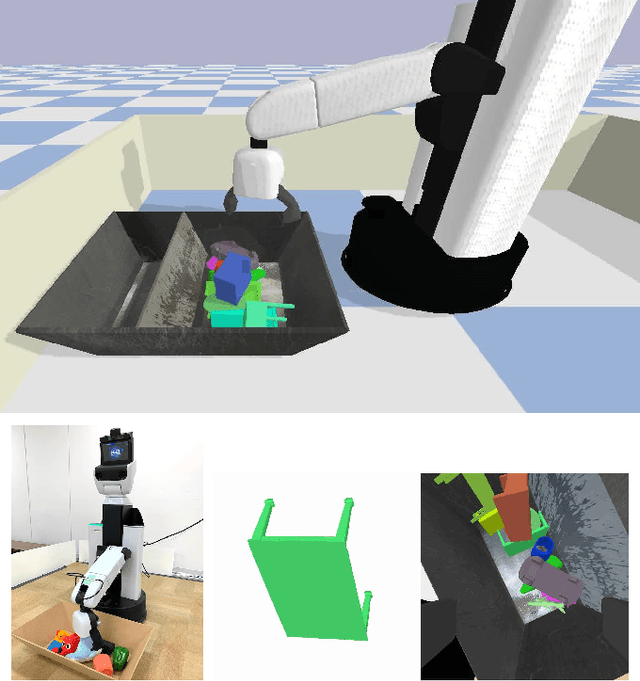
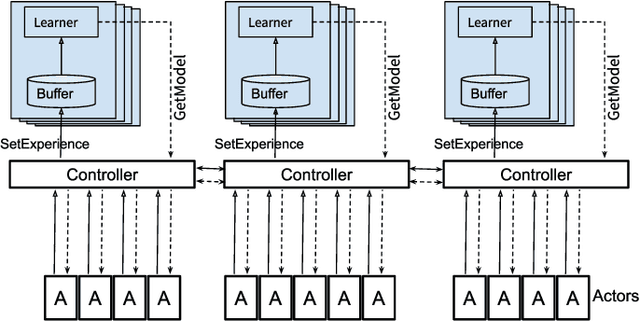
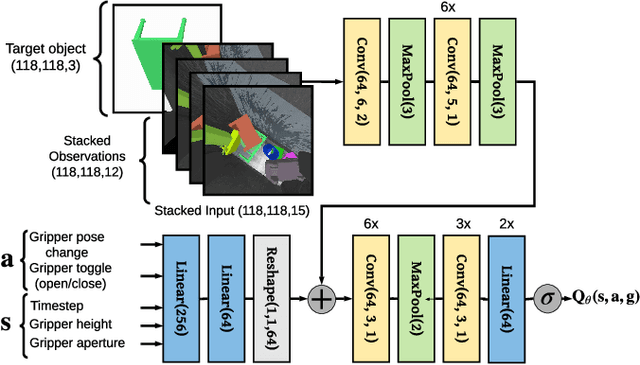
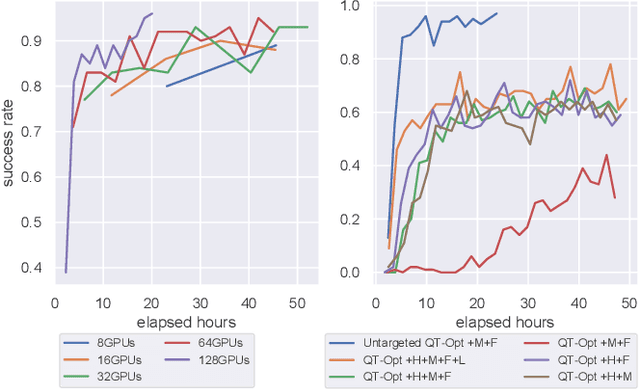
Abstract:Developing personal robots that can perform a diverse range of manipulation tasks in unstructured environments necessitates solving several challenges for robotic grasping systems. We take a step towards this broader goal by presenting the first RL-based system, to our knowledge, for a mobile manipulator that can (a) achieve targeted grasping generalizing to unseen target objects, (b) learn complex grasping strategies for cluttered scenes with occluded objects, and (c) perform active vision through its movable wrist camera to better locate objects. The system is informed of the desired target object in the form of a single, arbitrary-pose RGB image of that object, enabling the system to generalize to unseen objects without retraining. To achieve such a system, we combine several advances in deep reinforcement learning and present a large-scale distributed training system using synchronous SGD that seamlessly scales to multi-node, multi-GPU infrastructure to make rapid prototyping easier. We train and evaluate our system in a simulated environment, identify key components for improving performance, analyze its behaviors, and transfer to a real-world setup.
 Add to Chrome
Add to Chrome Add to Firefox
Add to Firefox Add to Edge
Add to Edge